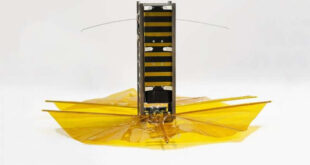A team of researchers at the Massachusetts Institute of Technology (MIT) has developed a thread-like ferromagnetic robot that can glide through complex and constrained environments, such as the labrynthine vasculature of the brain.
Kim et al developed robotic thread that can be steered magnetically and is small enough to work through narrow spaces such as the vasculature of the human brain; the researchers envision the technology may be used in the future to clear blockages in patients with stroke and aneurysms. Image credit: MIT.
To clear blood clots in the brain, doctors often perform an endovascular procedure, a minimally invasive surgery in which a surgeon inserts a thin wire through a patient’s main artery, usually in the leg or groin.
Guided by a radiation-generating fluoroscope that simultaneously images the blood vessels using X-rays, the surgeon then manually rotates the wire up into the damaged brain vessel.
A catheter can then be threaded up along the wire to deliver drugs or clot-retrieval devices to the affected region.
“The procedure can be physically taxing, requiring surgeons, who must be specifically trained in the task, to endure repeated radiation exposure from fluoroscopy,” said Yoonho Kim, a graduate student in MIT’s Department of Mechanical Engineering.
“It’s a demanding skill, and there are simply not enough surgeons for the patients, especially in suburban or rural areas.”
The medical guidewires used in such procedures are passive, meaning they must be manipulated manually, and are typically made from a core of metallic alloys, coated in polymer, a material could potentially generate friction and damage vessel linings if the wire were to get temporarily stuck in a particularly tight space.
Kim and colleagues combined their work in both hydrogels — biocompatible materials made mostly of water — and 3-D-printed magnetically-actuated materials to produce a magnetically steerable, hydrogel-coated robotic thread, which they were able to make thin enough to magnetically guide through a life-size silicone replica of the brain’s blood vessels.
The core of the robotic thread is made from nickel-titanium alloy called nitinol, a material that is both bendy and springy.
Unlike a clothes hanger, which would retain its shape when bent, a nitinol wire would return to its original shape, giving it more flexibility in winding through tight, tortuous vessels.
The scientists coated the wire’s core in a rubbery paste, or ink, which they embedded throughout with magnetic particles.
Finally, they used a chemical process they developed previously, to coat and bond the magnetic covering with hydrogel.
They demonstrated the robotic thread’s precision and activation by using a large magnet, much like the strings of a marionette, to steer the thread through an obstacle course of small rings, reminiscent of a thread working its way through the eye of a needle.
The authors also tested the thread in a life-size silicone replica of the brain’s major blood vessels, including clots and aneurysms, modeled after the CT scans of an actual patient’s brain.
They filled the silicone vessels with a liquid simulating the viscosity of blood, then manually manipulated a large magnet around the model to steer the robot through the vessels’ winding, narrow paths.
“The robotic thread can be functionalized, meaning that features can be added — for example, to deliver clot-reducing drugs or break up blockages with laser light,” Kim said.
“A magnetically steerable guidewire does away with the necessity for surgeons to physically push a wire through a patient’s blood vessels,” he added.
“This means that doctors also wouldn’t have to be in close proximity to a patient, and more importantly, the radiation-generating fluoroscope.”
The team’s work was published in the journal Science Robotics.
_____
Yoonho Kim et al. 2019. Ferromagnetic soft continuum robots. Science Robotics 4 (33): eaax7329; doi: 10.1126/scirobotics.aax7329
 #Bizwhiznetwork.com Innovation ΛI |Technology News
#Bizwhiznetwork.com Innovation ΛI |Technology News




